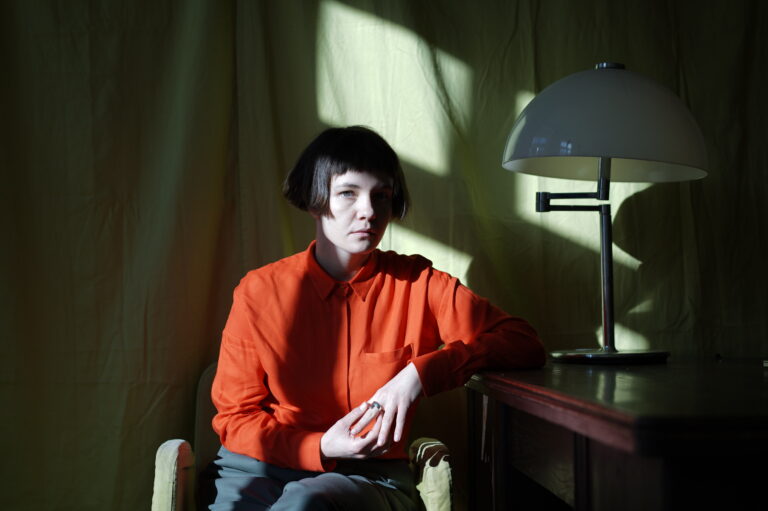

— born in 1991 — Ukrainian artist. Currently lives and works in Kyiv and Berlin. After finishing her bachelor in monumental painting at the Fine Art Academy in Kyiv, she completed the master program at the Berlin University of Arts. She is working in various techniques, such as drawing, animation, installations and text. A central point that connects these multimedia practices is that they are capturing times of transition in a society and how it impacts an individual. In her current projects, she is engaged with various aspects of time perception. She also participated in the residencies Kultur Kontakt Austria (2017), Museumsquartier Q21 Wien (2018) and Atelierhaus Salzamt Linz (2018).
Ruptures, transitional states and co-existence of different timelines, process of historical transition and people’s perception of time gaps, fragmentation and reassembly of fragments into something coherent — these could be defined as the range of subject-matters I work with. When with one foot you are in one time or a body, yet with the second one — in another. The experience of witnessing or participating in such events1, as well as the loss of coherence and re-assembling of a body are inscribed into my artistic practice2. Fragmentation and interruptions are applicable to both the choice of topics as well as the media that I work with.
I consider space to be the extension of a body, its second skin, which is characterized by the protection function and the one communicative with the environment3. Installation-based exhibition spaces play a role of exit models for me: exit from isolation, pain and immobility, from the unspoken. For the first time, it was flashing space with the ornament of a bodily movement4 or wandering the gaze and escaping from a motionless body5. This video is part of a series that has evolved into an overarching installation Leaving the town’s body: a map 6. It is the space that combines various plots of mental and bodily adaptation of a human being: an experience of disorientation in a city7, a loss of one’s own boundaries8, sleep deprivation and mental break-through9, and long-awaited “exit” of the body into the imaginary — into an image10.
“Getting out of the body is getting out of tightness. Through seeing, hearing, tactile sensations, the body expands its blending with the space and its objects. The touches merge with things, the gaze collides with the surface of the visible, the hearing catches echoes from the city’s far-away places. So, the boundaries of the tightness stretch”.
The stitching of scattered spaces by a single sun ray is the central element of the total installation called Your Rental Contract Has Been Terminated11. It combines the major lines of my artistic method: concerning both the choice of materials, as well as the structure of their interaction12. Within the state of nomadic and precarious life style, sun rays and certain rituals about the placement of the objects become anchors that shape one’s own home. “The key element that stitches the scattered spaces is the Sun. It shines through every past and future room. The sun comes from outside into the room, and as if it was on stage, and reveals everything that falls under its rays”1314.
I am interested in the non-linear nature of history and co-existence of various lines that stretch from the past intertwining with the people’s destinies15. The political and social fracture that shapes a person’s everyday life — whether throws him/herself into the outskirts, or isolates him/herself from resources and professional opportunities, trauma, independent children’s upbringing, social crisis which one is all of a sudden not ready for. Diploma thesis16 is the joint work with Svitlana Seleznova, my mother and an artist who works with textiles17. This is a retrospective into the origins of one’s social opportunities and their comparison with the ones that were available to her in the early 1990s18.
Throughout my entire conscious life, I have been witnessing the shift of the dominant language’s position in my bilingual country. The traumatic experience of the “smaller” language in relation to the “imperial” one influenced the methods by which the first one regained its major position. At times, the methods were artificial or ignored by yet dominant Russian. Bilingualism was natural to me, I chose Ukrainian as my native tongue when I was a child. After that, I have been using both languages as waves that cannot exist without each other. Later, German became like the third native tongue: it is one of the acquired prisms, which supports the nomadic view over the transitional states and ruptures. This has become part of my work with texts in German and collaborations with the German authors1920.
The final version of the statement was edited in collaboration with Kateryna Rusetska (2022).
1Image: Dariia Kuzmych, Overthrow of the Lenin monument in Kharkiv, 2015, 180 x 180 cm, oil on canvas. Courtesy of the artist.2See: instagram.com/eyeontheknee/.
3Maurice Merleau-Ponty, The Visible and the Invisible, Followed by Working Notes trans. by Alphonso Lingis, Evanston, Northwestern University Press, 1968.
4Image: Dariia Kuzmych, Frame from the video installation Acceptance, 2014, loop. Courtesy of the artist.
5Image: Dariia Kuzmych, Video still from Gaze owner, video with animation, 2016. Courtesy of the artist. See: dariiakuzmych.com/Gaze-owner/.
6Image: Dariia Kuzmych, Fragment of the installation Leaving the town’s body: a map, 2018, during the Architecture of voice festival curated by Ukho agency, Plivka art centre. Courtesy of the artist. See: dariiakuzmych.com/Leaving-the-town-s-body-a-map/.
7Image: Dariia Kuzmych, Video still from Ruine or a shell, animation, 2016-2018. See: dariiakuzmych.com/Ruine-or-a-shell/. Courtesy of the artist.
8Image: Dariia Kuzmych, View of the exhibition "Leaving the town’s body: a map", Collective, animation, 2016. See: dariiakuzmych.com/Collective/. Courtesy of the artist.
9Image: Dariia Kuzmych, View of the exhibition "Leaving the town’s body: a map". Courtesy of the artist.
10Gaston Bachelard, The poetics of space, Presses Universitaires de France, 1958.
11Image: Dariia Kuzmych, View of the exhibition "Your rental contract has been terminated", 2020. Courtesy of the artist.
12Image: Dariia Kuzmych, View of the exhibition "Your rental contract has been terminated", 2020. See: dariiakuzmych.com/Your-rental-contract-has-been-terminated/. Courtesy of the artist.
13Image: Dariia Kuzmych, View of the exhibition "Your rental contract has been terminated", 2020.See: supportyourart.com/columns/prozhyvaty-prostir/. Courtesy of the artist.
14Image: Dariia Kuzmych, View of the exhibition "Your rental contract has been terminated", 2020. Courtesy of the artist.
15Image: Dariia Kuzmych, View of the installation Dresden, People in the square, 2017. Courtesy of the artist. See: dariiakuzmych.com/Dresden-People-in-the-square.
16 Image: Dariia Kuzmych, Diploma thesis, 2018, in collaboration with Svitlana Selezneva, quilt and embroidery, 210 x 210 cm. See: dariiakuzmych.com/Diploma-thesis. Courtesy of the artist.
17See: cargocollective.com/seleznevasveta/works.
18Image: Dariia Kuzmych, View of the installation Diploma thesis, 2018. Courtesy of the artist.
19See: dariiakuzmych.com/How-does-it-happen/.
20See: www.triedere.com/.
– народилась в 1991році – українська художниця. Живе і працює в Києві та Берліні. Після закінчення бакалаврської програми з монументального живопису в Академії образотворчого мистецтва в Києві, закінчила магістерську програму в Берлінському університеті мистецтв. Працює в різних техніках, таких як рисунок, анімація, інсталяції та текст. Центральним моментом, який об’єднує ці мультимедійні практики, є те, що вони фіксують перехідний період у суспільстві та те, як це впливає на людину. У своїх поточних проектах займається різними аспектами сприйняття часу. Брала участь у резиденціях Kultur Kontakt Austria (2017), Museumsquartier Q21 Wien (2018) та Atelierhaus Salzamt Linz (2018).
Розриви, перехідні стани та співіснування різних часових ліній, процес історичного переходу та сприйняття людьми касових розривів, фрагментарність та перезбирання фрагментів у щось цілісне — так можна означити спектр тем, з якими я працюю. Коли однією ногою в одному часі або тілі, другою — в іншому. Досвід свідка чи учасниці у таких подіях1, а також втрата цілісності та перезбирання тіла вписані у мою художню практику2. Фрагментарність та уривчастість стосується як вибору тем, так і медіумів, з якими я працюю.
Я бачу простір продовженням тіла, його другою шкірою, якій властива як функція захисту, так і комунікації з оточенням3. Інсталятивні експозиційні простори грають для мене роль моделей виходу: з ізоляції, болю, нерухомості, з невимовленого. Вперше це було прошивання простору орнаментом тілесного руху4 або ж блукання погляду та втеча з нерухомого тіла5. Це відео — частина серії, яка розвинулась у тотальну інсталяцію «Карта виходу з тіла міста»6. Це простір, який поєднує в собі різні сюжети ментальної та тілесної адаптації людини: досвіди дезорієнтації в місті7, втрати власних кордонів8, депривації сну та психічного розриву9 й омріяного «виходу» з тіла в уявне, в образ10.
«Вихід із тіла — це вихід зі щільності. Через погляд, слух, тактильні відчуття тіло розширюється, змішуючись із простором та його об’єктами. Дотики поєднують із предметами, погляд зіштовхується з поверхнею видимого, слух ловить відлуння з віддалених частин міста, так простягаються кордони щільності».
Зшивання розрізнених просторів єдиним променем сонця є центральним елементом у тотальній інсталяції «Твій контракт оренди скасовано»11. Вона поєднує в собі основні лінії моєї художньої методи: як у виборі матеріалів, так і в структурі їхньої взаємодії12. У стані номадичного та прекарного способу проживання промені сонця та певні ритуали розташування предметів стають якорями, які формують власну домівку. «Ключовим елементом, що зшиває розрізнені простори, є Сонце. Воно світить у кожну минулу і майбутню кімнату. Сонце заходить в кімнату ззовні і, ніби на сцені, проявляє все, що потрапляє під його промені»1314.
Мене цікавить нелінійність історії та співіснування різних ліній, які тягнуться з минулого, переплітаючись через долі людей15. Політичний та суспільний розлам, який формує повсякдення людини, чи то відкидає її на околицю, чи ізолює від ресурсів та професійних можливостей: травма, самостійне виховання дітей, суспільна криза, до якої ти раптом не готова.
«Дипломна робота»16 — це спільна робота зі Світланою Селезньовою, моєю мамою та художницею, яка працює з текстилем17. Це погляд назад, у витоки своїх соціальних можливостей та порівняння їх із тими, які були доступні на початку 90-х для неї18.
Протягом усього свого свідомого життя я була свідком зміни позиції домінантної мови у своїй білінгвальній країні. Травматичний досвід «меншої» мови відносно «імперської» вплинув на методи повернення її основної позиції. Вони часом були штучними або ж ігнорованими все ще домінантною російською. Білінгвальність була для мене органічною, і українську я обрала своєю рідною в дитинстві, після чого користуюсь обома мовами як фазами хвиль, які не можуть існувати одна без одної. Пізніше німецька стала ніби третьою рідною: вона є однією з набутих призм, яка підтримує номадичний погляд на перехідні стани та розриви. Це стало частиною моєї практики з текстами німецькою та колабораціями з німецькомовними автор(к)ами1920.
Текст створений у співпраці з кураторкою Катериною Русецькою (2022).
1Зображення: Дарія Кузьмич, Повалення пам’ятника Леніну в Харкові, 2015 рік, 180 х 180 см, олія на полотні. Зображення надано авторкою.2Див: /instagram.com/eyeontheknee/
3Maurice Merleau-Ponty, The Visible and the Invisible, Followed by Working Notes trans. by Alphonso Lingis, Evanston, Northwestern University Press, 1968.
4 Зображення: Дарія Кузьмич, Кадр з відеоінсталяції «Прийняття», 2014, loop. Зображення надано авторкою.
5Зображення: Дарія Кузьмич, Кадр з відеороботи «Погляд власника», відео з анімацією, тривалість: 05:36, 2016 Зображення надано авторкою. Див. dariiakuzmych.com/Gaze-owner/.
6Зображення: Дарія Кузьмич, Фрагмент інсталяції «Покидаючи тіло міста: карта», 2018, фестиваль «Архітектура голосу», куратором якого є агентство «Ухо», арт-центр «Плівка» Див. dariiakuzmych.com/Leaving-the-town-s-body-a-map/.
7Зображення: Дарія Кузьмич, Відео кадр із «Руїни або мушлі», анімація, тривалість: 02:44 хв, 2016-2018. Зображення надано авторкою. Див. dariiakuzmych.com/Ruine-or-a-shell/.
8Зображення: Дарія Кузьмич, Відео кадр із «Руїни або мушлі», анімація, тривалість: 02:44 хв, 2016-2018. Зображення надано авторкою. Див. dariiakuzmych.com/Collective/.
9Зображення: Дарія Кузьмич, Відео кадр із «Руїни або мушлі», анімація, тривалість: 02:44 хв, 2016-2018. Зображення надано авторкою.
10Гастон Башляр, Поетика космосу, Presses Universitaires de France, 1958.
11Зображення: Дарія Кузьмич, Експозиція «Ваш договір оренди розірвано», 2020. Зображення надано авторкою.
12Зображення: Дарія Кузьмич, Експозиція «Ваш договір оренди розірвано», 2020. Зображення надано авторкою. Див: dariiakuzmych.com/Your-rental-contract-has-been-terminated/.
13Зображення: Дарія Кузьмич, Експозиція «Ваш договір оренди розірвано», 2020. Зображення надано авторкою. Див: supportyourart.com/columns/prozhyvaty-prostir/.
14Зображення: Дарія Кузьмич, Експозиція «Ваш договір оренди розірвано», 2020. Зображення надано авторкою.
15Зображення: Дарія Кузьмич, Інсталяція, Дрезден. Люди на площі, 2017. Зображення надано авторкою. Див. dariiakuzmych.com/Dresden-People-in-the-square.
16Зображення: Дарія Кузьмич, Дипломна робота, 2018 р., співавтор Світлана Селезньова, ковдра та вишивка, 210 х 210 см. Зображення надано авторкою. Див. dariiakuzmych.com/Diploma-thesis.
17Див: cargocollective.com/seleznevasveta/works.
18Зображення: Дарія Кузьмич, Інсталяція «Дипломна робота», 2018. Зображення надано авторкою.
19Див: dariiakuzmych.com/How-does-it-happen/.
20Див: /triedere.com/.